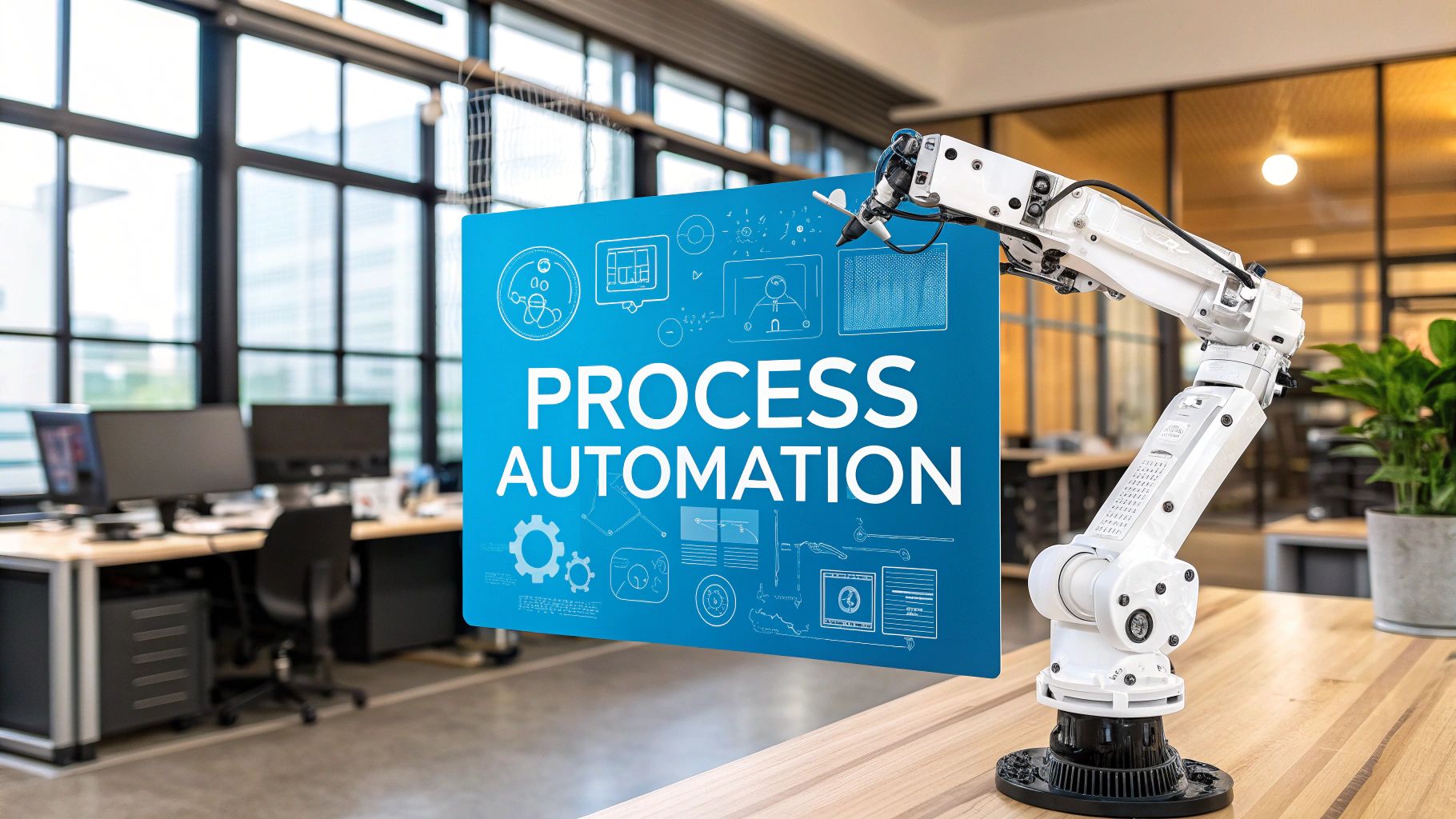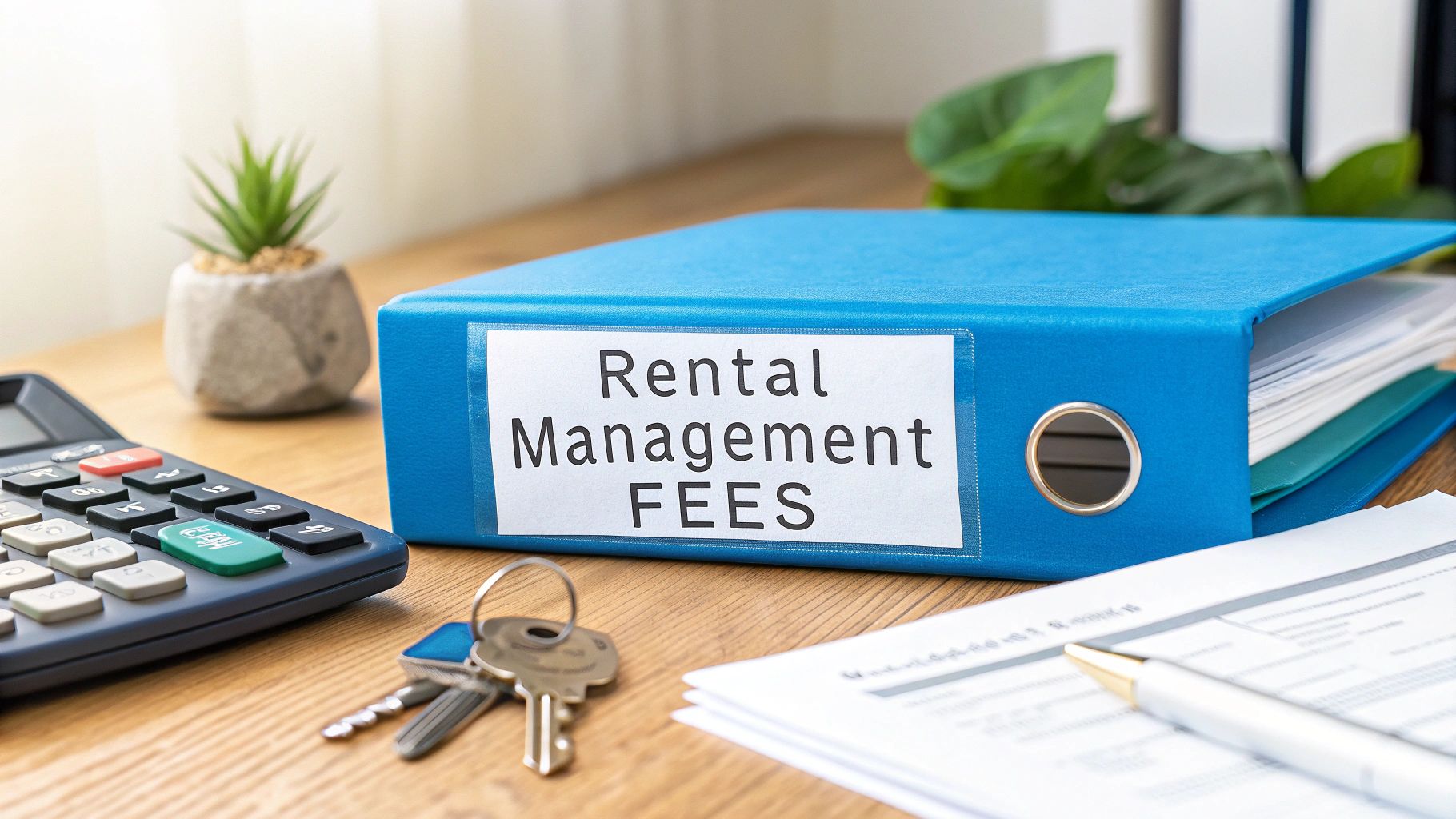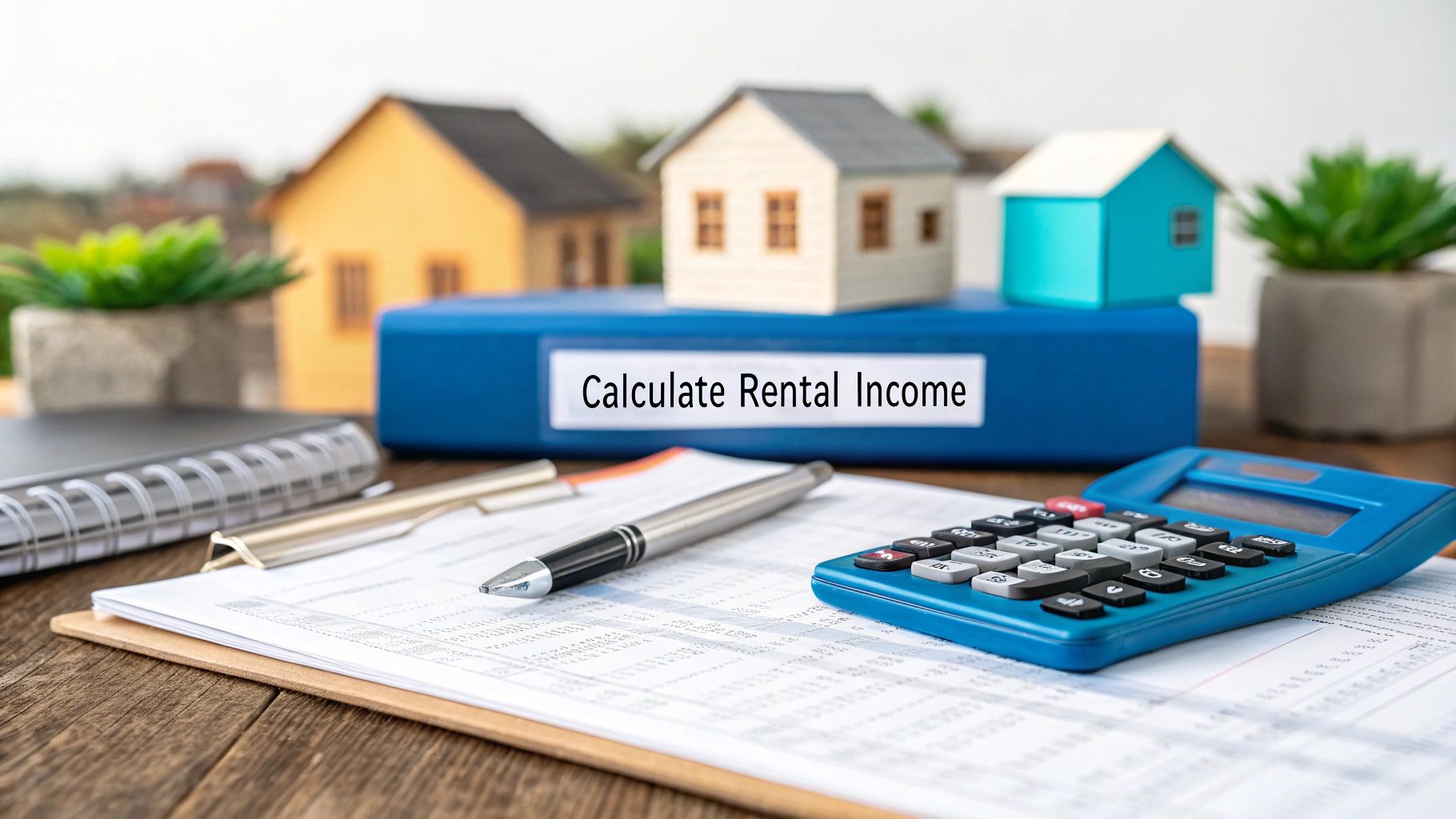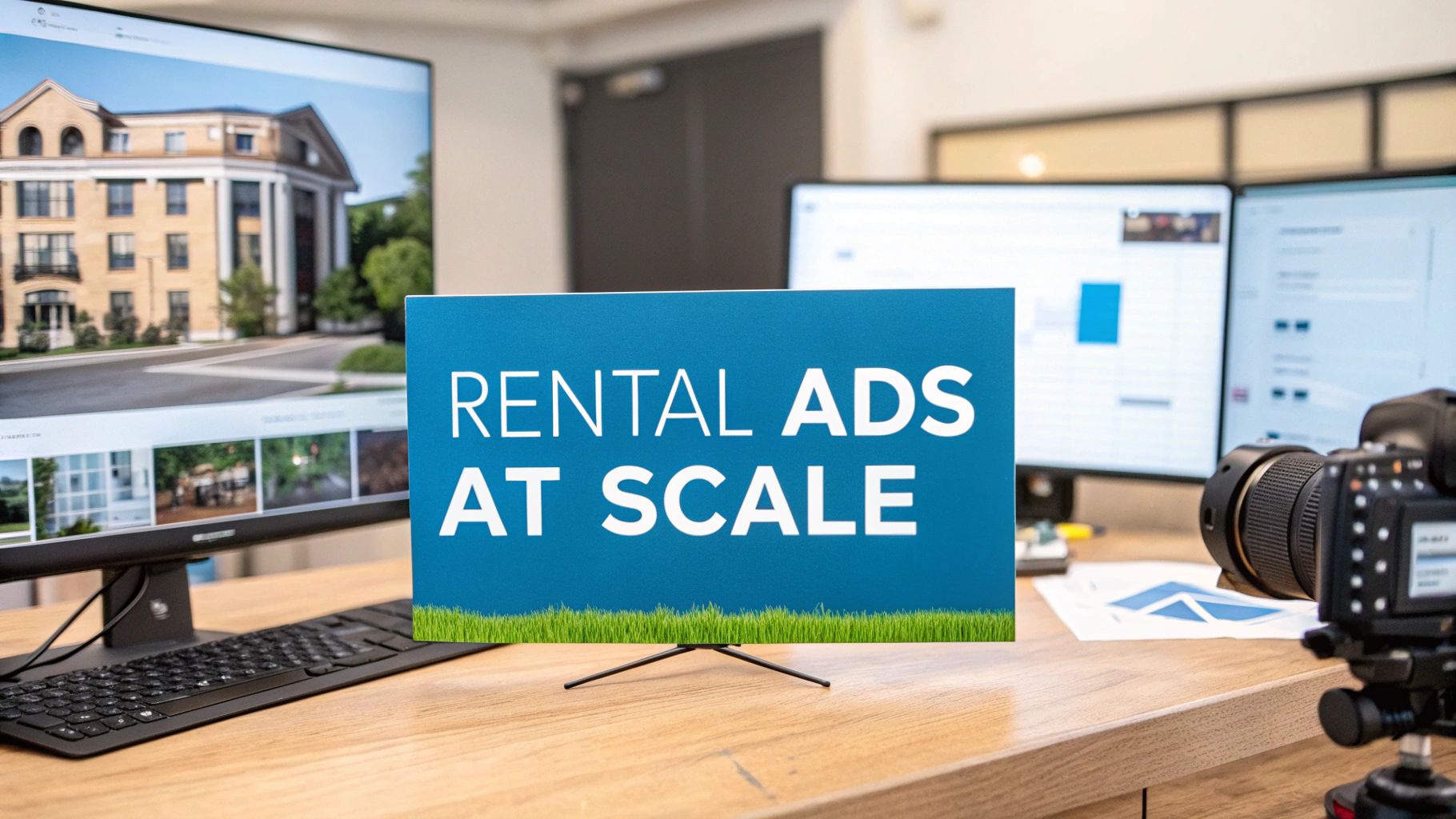When you're managing hundreds, or even thousands, of rental units, old-school manual processes aren't just inefficient—they're a direct threat to your bottom line. To achieve true operational scalability, you must systemize your operations through automation. This starts by pinpointing the repetitive, time-consuming tasks in your leasing funnel, like lead follow-up and tour coordination, and deploying technology to execute them flawlessly. This frees up your property managers for high-value work, slashes your Days on Market (DOM), and directly increases net operating income.
Why Automating Property Management Is No Longer Optional

In large-scale property management, the friction from manual work isn't a minor headache; it's a significant drain on your portfolio's revenue. Every hour a leasing agent spends manually assigning leads, juggling schedules across a dispersed portfolio, or entering prospect data into a PMS is an hour a qualified renter could have been touring a unit. That delay is where you start leaking revenue, and it compounds quickly when you're managing a portfolio of over 1,000 doors.
For enterprise-level operators, the pain points are nearly universal:
- Coordinating Showings at Scale: Managing tour schedules across multiple markets without onsite staff is a logistical nightmare that slows down leasing velocity.
- Standardizing Lead Follow-up: Ensuring every lead receives a rapid, professional response is nearly impossible to execute consistently at scale with manual processes.
- Reducing Days on Market (DOM): Every day a unit sits vacant is a day of lost revenue. Slow, manual leasing workflows directly inflate your DOM and erode asset value.
For large portfolios, the most critical metric is speed-to-lease. The first property manager to get a qualified prospect through the door is overwhelmingly the one who secures the signed lease. Automation is the bridge that closes the critical gap between a lead's initial inquiry and the property tour.
The Financial Case for Automation
The conversation around automation has shifted from a "nice-to-have" tool for marginal efficiency gains to a core strategy for financial performance and growth. This isn't just a property management trend. The global industrial automation market is projected to hit $227 billion by 2025, with businesses reporting significant operational cost reductions. For large-scale property managers laser-focused on cost-per-door, this translates directly to the bottom line.
Let's calculate the financial impact for a 1,000-unit portfolio. If the average property rents for $2,100 a month ($70/day), trimming your average DOM by just five days means you recapture $350 in revenue per unit turn. Across your portfolio, that single improvement can drive a $350,000 positive impact on your annual revenue. The ROI is clear and compelling.
The table below breaks down how replacing manual processes with automated solutions directly improves key performance indicators (KPIs) for enterprise property managers.
Impact of Automation on Key Property Management Metrics
As you can see, the connection between specific automation tools and tangible financial outcomes is direct and measurable.
From Putting Out Fires to Driving Growth
Without automation, your team is trapped in a reactive cycle of firefighting—chasing down leads, fixing scheduling conflicts, and manually keying in data. This mode leaves zero bandwidth for the strategic work that actually grows the business, such as nurturing owner relationships or analyzing portfolio performance.
A modern PropTech stack flips this script. By implementing systems to handle the top of the leasing funnel automatically, you build a scalable machine for growth. It’s about more than saving a few hours; it’s about creating a system that optimizes your most critical KPIs—like lead-to-tour conversion and DOM—without requiring constant human intervention. For a more detailed walkthrough, this comprehensive guide on how to automate business processes offers valuable context.
Achieving these efficiencies is a foundational step for any large-scale operation. You can learn more about achieving efficiencies in property management and how it directly impacts your bottom line.
Mapping Your Workflows for Automation Success

Before you evaluate any software, successful automation begins with a rigorous analysis of your current operational workflows. For property managers handling large, distributed portfolios, this means moving beyond assumptions and creating a detailed blueprint of your most critical processes.
This isn't an abstract exercise. It’s a strategic mapping process designed to expose every bottleneck, delay, and manual touchpoint that is costing you revenue and inflating your Days on Market (DOM). Think of it as a diagnostic exam for your entire lead-to-lease funnel.
Identifying High-Impact Processes
Not all processes are created equal. When prioritizing where to start, focus on the workflows that directly impact your most critical metrics: speed-to-lease and operational cost-per-door. For any large, multi-market portfolio, these nearly always include:
- Lead Intake and Initial Response: How quickly do you respond to a new prospect from Zillow or Apartments.com? A delay of even a few minutes can be the difference between a booked tour and a lost lead.
- Tour Scheduling and Confirmation: What are the exact steps required to get an interested prospect scheduled for a showing? This is a classic operational bottleneck, filled with manual emails and phone tag.
- Agent Dispatching: For portfolios without dedicated onsite staff, how do you assign and notify a showing agent? Any friction here brings the leasing process to a halt.
- Post-Tour Follow-Up: What happens after a prospect tours a property? Without a standardized, timely follow-up process, qualified applicants will fall through the cracks.
Mapping isn't just an internal checklist. Understanding your core operations, like streamlining your month-end closing process, establishes the foundation for any successful technology implementation. This work ensures you build automated systems that solve real business problems.
A Real-World Workflow Breakdown
Let’s walk through a real-world example. Imagine a property management company with a 1,500-unit portfolio spread across three different states. Their primary objective is to reduce their average DOM from 28 days to under 21.
By flowcharting their lead-to-tour process, they uncovered a massive bottleneck. When a lead comes in, it's manually forwarded to a regional leasing coordinator. That coordinator then emails a list of available tour times to the prospect. This game of "schedule tennis" adds an average of 24 to 48 hours to their response time. In that critical window, hot leads are actively booking tours with competitors.
This delay is precisely where automation delivers its highest ROI. By identifying this specific friction point, the company knows exactly where to deploy technology—in this case, an automated self-scheduling system—to eliminate the lag and accelerate the entire leasing cycle.
Pinpointing Your Automation Opportunities
Once you have your workflows mapped, the next step is to pinpoint the moments ripe for automation. You're looking for the red flags that signify inefficiency and lost revenue.
Your Automation Hit List Should Include:
- Repetitive Data Entry: Tasks like copying lead information from an email into your property management software are prime candidates for automation. They are low-value, error-prone, and inefficient.
- Time-Based Triggers: Any action that needs to happen after a specific time—like following up with a prospect 24 hours after their tour—should be automated to ensure 100% consistency.
- Cross-System Updates: If your team must update a lead's status in multiple systems (your showing software, your PMS, a spreadsheet), this is a clear sign that you need an integration-powered automation.
- Manual Triage and Assignment: Any process dependent on a human to manually review and assign leads, tasks, or agents is a bottleneck. It slows your response time and damages your lead-to-tour conversion rate.
By completing this thorough mapping exercise, you are no longer guessing where technology might help. You are creating a data-driven blueprint that connects specific automation tools directly to your goals of lower DOM, reduced operational costs, and a healthier bottom line.
Building Your Scalable Automation Technology Stack

With a clear map of your workflows, it's time to build the technology infrastructure that enables your automation strategy. For a large portfolio, this isn't about finding a single "all-in-one" solution. It’s about creating a powerful, interconnected ecosystem where best-in-class tools work in concert to eliminate manual work and accelerate your entire leasing funnel.
This strategic collection of software is your PropTech stack. At its core, a scalable stack for enterprise property management requires three pillars: your Property Management System (PMS), a specialized showing management platform, and your Customer Relationship Management (CRM) system. The real power lies not in any single platform, but in how seamlessly they integrate.
The Central Role of API Integrations
The essential component that makes a modern PropTech stack function is the Application Programming Interface, or API. An API acts as a secure data messenger, allowing your different software systems to communicate and share information automatically. This is the bedrock of true, hands-off automation for remote property management operations.
Without robust API connections, your team is trapped in "swivel-chair integration"—manually copying data from one screen and pasting it into another. This wastes countless administrative hours and is a primary source of data errors that can derail your leasing process.
A well-integrated stack provides a single source of truth. When a lead's status is updated in one platform, that change instantly propagates across all connected systems, from your showing schedule to your main PMS dashboard. This system-wide consistency is non-negotiable for managing multi-market operations at scale.
This kind of workflow automation is seeing massive investment globally. The market was valued at $19.76 billion in 2023 and is projected to more than double by 2032. For property managers, this translates to real results: businesses report that automation can reduce process errors by as much as 70%, a game-changing improvement for any data-intensive operation.
Anatomy of an Enterprise PropTech Stack
So, how do these systems work together to create a seamless leasing machine? When properly integrated, your stack automates the entire journey from a prospect's first inquiry to a scheduled tour.
Here’s a real-world example of an integrated workflow:
- A prospective renter finds your vacant unit on a listing site and submits an inquiry.
- The API connection between the listing site and your CRM instantly captures the lead's information. No manual data entry is required.
- This new lead automatically triggers an action in your showing platform, like Showdigs. The system immediately texts the prospect a link to self-schedule a tour.
- Once the prospect books a time, the showing platform's API updates the lead's status to "Tour Scheduled" in both your CRM and your central PMS (like Appfolio or Rentvine).
This entire sequence occurs in minutes, 24/7, with zero human intervention. It ensures every hot lead receives an immediate response, which dramatically increases your lead-to-tour conversion rate and shaves critical days off your vacancy time.
Evaluating Technology for Scalability
When evaluating new software for your stack, look beyond surface-level features. For enterprise portfolios, your evaluation must be laser-focused on scalability, integration capabilities, and the direct impact on your financial metrics.
Your Technology Evaluation Checklist:
- Robust API and Integration Capabilities: Does the platform offer a well-documented, open API? Does it have pre-built integrations with the core systems your business relies on?
- Scalability to 10,000+ Units: Can the system handle the data volume and user load of a large, multi-market portfolio without performance degradation?
- Impact on Key Metrics: Can the vendor demonstrate how their solution will lower your Days on Market, increase lead-to-tour conversion, and reduce your cost-per-door?
- Specialization and Focus: Does the tool excel at solving one specific, high-value problem (like tour scheduling), or is it a jack-of-all-trades? The most effective stacks are built from specialized, integrated, best-in-class solutions.
Choosing the right technology and ensuring it integrates flawlessly is how you build an operational backbone that supports growth instead of hindering it.
Putting Automation to Work for Maximum Revenue Impact
You’ve mapped your workflows and selected your technology. Now it’s time for implementation, where automation will make the biggest impact on your bottom line. This isn't about flipping a single switch; it's a strategic rollout focused on the most critical, high-impact process in property management: the lead-to-lease cycle.
Our goal is to create automated rules that directly attack your most expensive problems—vacancy loss and the operational drag that causes it. This is where theory becomes tangible revenue. Let's move from planning to action by building specific automation rules you can implement immediately to shorten your leasing cycle.
This graphic breaks down the journey of bringing an automation plan to life, from initial design through to performance monitoring.
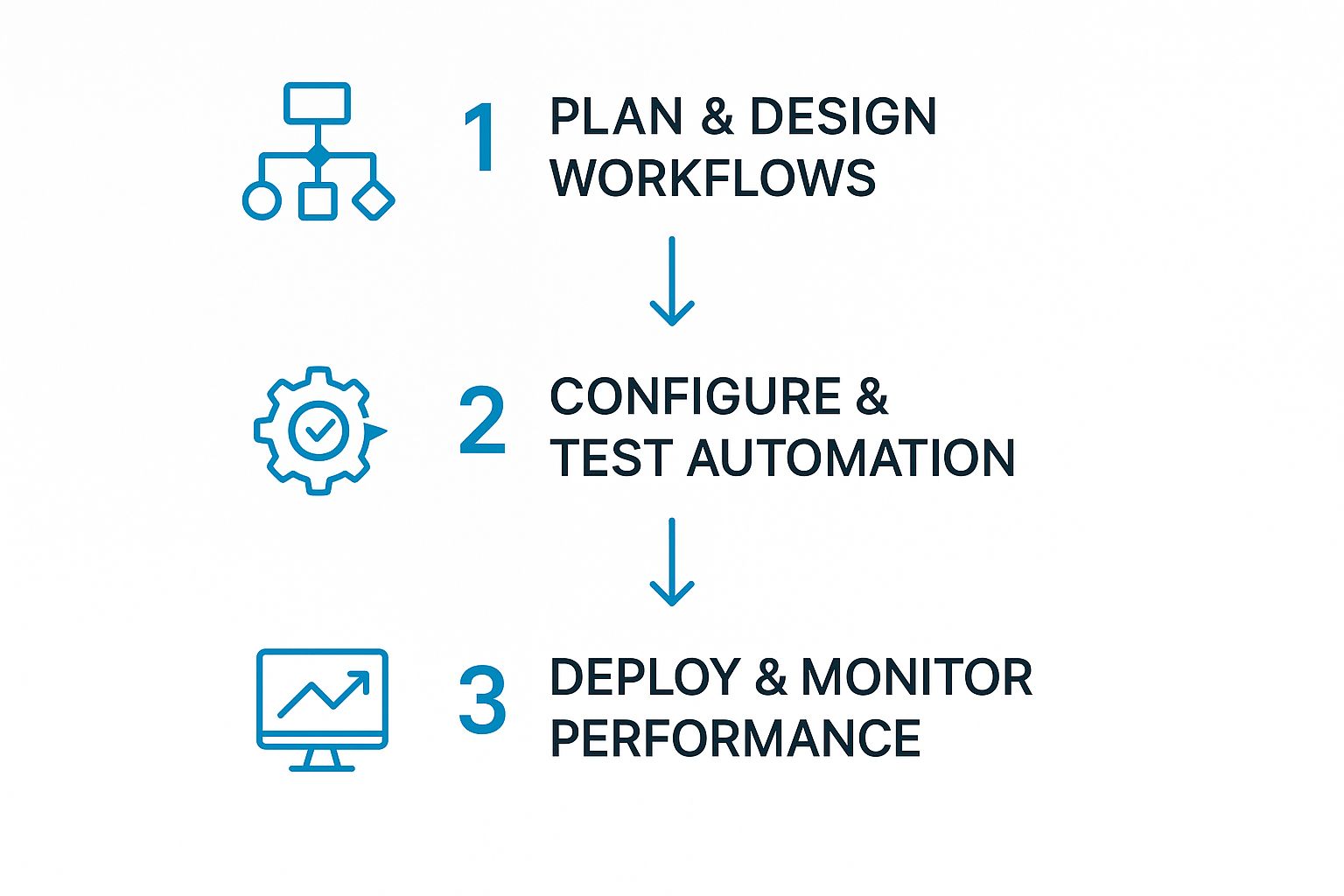
As you can see, it’s a structured, three-part process. Successful implementation isn't a one-and-done task; it requires careful planning, rigorous testing, and ongoing oversight to achieve and maintain peak performance.
Creating High-Impact Automation Rules
Your first automations should be laser-focused on the biggest drop-off points in your leasing funnel. You're using technology to guarantee speed and consistency—two elements that are nearly impossible to maintain manually, especially as your portfolio scales.
Here are three powerful automation rules to build first:
- The Instant-Response Rule: The moment a new lead is captured from any source—a listing site, your website, etc.—an automation rule triggers a personalized SMS message. This text must include the property address and a direct link for the prospect to self-schedule a tour. This single rule eliminates manual response lag and engages hot leads in seconds.
- The Smart Dispatch Rule: As soon as a prospect books a tour, the system automatically assigns the nearest, highest-rated showing agent from your network. This removes your leasing coordinator from the manual scheduling process of cross-referencing calendars and locations. A qualified agent is assigned instantly.
- The Post-Tour Nurture Rule: Approximately 24 hours after a tour concludes, an automated follow-up email or text is sent. This message thanks them for visiting, provides a direct link to the application, and asks if they have any remaining questions.
These rules aren't just about efficiency. They are specifically designed to systematically improve your lead-to-tour conversion rate and slash your Days on Market (DOM).
Mini Case Study: A 2,000-Unit Operator Recaptures Revenue
A multi-market property management company with 2,000 single-family rentals was struggling with an average DOM of 25 days. A workflow analysis revealed their biggest bottleneck was the manual back-and-forth of coordinating showing schedules.
By implementing an automated showing system, they established rules for instant lead response and self-service tour booking. The results were immediate. Their average DOM dropped by 7 days, from 25 down to 18.
With an average rent of $2,100/month (or $70/day), saving 7 days per vacancy translated into $490 in recaptured revenue per unit turn. Across their portfolio, this single operational change unlocked significant financial gains and dramatically improved their speed-to-lease.
Understanding the Financial Power of Automation
This type of targeted automation is a form of Robotic Process Automation (RPA), which means using technology to handle rules-based tasks. It has become a cornerstone of modern operational strategy in asset-heavy industries.
The global RPA market is currently valued at a staggering $22.79 billion because the financial benefits are undeniable. It is common to see an ROI for RPA investments between 30% and over 200% in the first year alone. It’s a game-changer for boosting efficiency.
By focusing your initial automation efforts on the revenue-critical lead-to-lease process, you create immediate, measurable improvements in your portfolio's performance. You stop leaking potential income through slow, manual work and start building a scalable, efficient leasing machine that operates 24/7. This is how you automate business processes not just for efficiency, but for a direct and substantial impact on your revenue.
Measuring and Optimizing Your Automation ROI
Getting your automated workflows operational is a significant milestone, but it's just the beginning. The real value is unlocked when you begin refining those workflows with real-world data. This is not a 'set it and forget it' exercise; it is a dynamic system you must constantly tune to maximize portfolio performance.
For property managers of large portfolios, this requires building a culture of measurement. The goal is to move beyond surface-level metrics and understand precisely how automation is impacting the financial health of your leasing operations. You need to ask not just, "Is this working?" but "How much value are we creating, and how can we optimize further?"
Defining Your Key Performance Indicators
To prove the value of automation, you must track the right metrics. Your Key Performance Indicators (KPIs) should be the north star for your operations team, providing a clear, unbiased view of performance. Avoid getting lost in vanity metrics and focus on the numbers that directly affect your bottom line.
Your Core Automation KPIs:
- Days on Market (DOM) Reduction: This is the ultimate metric. Track your average DOM before and after implementing automation. The difference is a direct measure of your impact on vacancy loss.
- Lead-to-Tour Conversion Rate: What percentage of inquiries result in a booked tour? A rising conversion rate is a strong indicator that your instant response and self-scheduling systems are effective.
- Cost-Per-Showing and Cost-Per-Lease: Quantify your operational savings. By measuring the reduction in time your team spends on manual scheduling and follow-up, you can calculate the real-dollar savings in administrative overhead.
- Agent Performance Metrics: For multi-market portfolios utilizing an agent network, monitor metrics like showing acceptance rates, on-time arrivals, and prospect feedback scores to maintain consistent quality control across all regions.
The most successful large-scale property management companies treat their leasing funnel like a science. They understand that a 1% improvement in lead conversion or shaving one day off the average DOM can translate to tens of thousands of dollars in recaptured revenue when operating at scale.
A Framework for Continuous Optimization
Once you are tracking these KPIs, you can begin to refine your workflows. The most effective method for this is A/B testing—a simple approach to comparing two versions of a process to determine which performs better. This removes guesswork and allows you to make strategic changes backed by hard data.
For example, you could test two different automated follow-up messages for prospects who just completed a tour:
- Group A: Receives an automated SMS message 1 hour after their tour with a link to the application.
- Group B: Receives an automated email 24 hours after their tour with the same application link.
After running the test for a few weeks, analyze the data. Which group submitted more applications? The winner becomes your new standard operating procedure. This systematic approach allows you to continuously sharpen your automation for maximum impact. To dive deeper into how small tweaks fit into a larger strategy, you can find valuable insights to improve property management operations and drive even better results.
Building Your Performance Dashboard
To keep these metrics front and center, build a simple, centralized performance dashboard. This can be created using a business intelligence tool or even a shared spreadsheet. The purpose is to create a single source of truth that your entire operations team can rally around.
Sample Dashboard Components:
By consistently measuring, testing, and refining, you transform automation from a simple tool into a powerful engine for portfolio growth. This is how you move beyond one-time efficiency gains to achieve sustained, long-term optimization.
FAQs: Answering the Tough Questions on Automation at Scale
When you're managing a portfolio of 1,000+ units, the old ways of doing things just don't scale. You start wondering how you can possibly automate without making your business feel like a cold, impersonal machine.
It's a valid concern, and one we hear all the time from large operators. The questions are usually the same, circling around speed-to-lease, keeping things personal, and, of course, the bottom line.
- What's the very first thing we should automate?
- How do we keep that human touch with tenants when a bot is involved?
- Will this even work across our properties in different cities?
- What kind of ROI can we realistically expect?
These aren't just minor queries; they're the foundation of a solid automation strategy. Answering them helps you build a real-world blueprint that aligns your tech with your operational goals, moving you past those manual silos that slow everything down.
Let's dig into the answers.
What's the First Process a Large Property Management Company Should Automate?
Start where the money is: lead response and tour scheduling. Every minute you waste here directly adds to your Days on Market (DOM).
When a lead comes in, the clock is ticking. By setting up automated lead intake that instantly texts a self-scheduling link, you're meeting prospects where they are. In fact, industry data shows this simple change can boost your lead-to-tour conversion by over 30%.
Focus on automating the leasing funnel from top to bottom. It's the fastest way to capture revenue and cut down on costly vacancies.
This is all about anticipating what a prospect needs before they even have to ask. Automated outreach should provide clear next steps and answer common questions. A quick chatbot response can handle the basics, freeing up your team to focus on giving fantastic, personalized tours.
Here’s what that looks like in practice:
- Instantly auto-respond with links to a property video tour.
- If a prospect's schedule conflicts with an agent's, offer a self-tour option right away.
- Send simple SMS updates and reminders before and after showings.
We saw a 3,000-unit portfolio lift their pre-tour engagement by 25% just by mixing automated SMS videos with a self-booking link. It works.
How Do We Ensure Automation Doesn't Feel Robotic?
Personalization is key. You can maintain a warm, consistent experience by using message tokens—like the prospect's name and the specific property address—in your automated texts and emails.
This way, your system is handling the routine reminders and confirmations, but the message still feels like it’s coming from a person.
- Use dynamic fields to personalize your SMS messages.
- Schedule automated check-ins at logical points, not just randomly.
- Create a clear handoff point where a human agent can step in for more complex conversations.
The goal isn't to replace your team; it's to shorten the manual handoffs and eliminate the back-and-forth of scheduling. This means fewer missed appointments and a much tighter leasing funnel, especially when you're managing thousands of units.
How Does Automation Help Manage Properties Across Multiple Markets?
This is where a centralized system really shines. An automation engine ensures every single lead and tour follows the same standard operating procedure, whether the property is in Atlanta or Austin.
You can dispatch vetted, local agents on demand through a platform like Showdigs, enforce compliance rules system-wide, and capture standardized data directly in your property management software—all automatically.
By standardizing your rules, you cut down on the need for endless local training. Central dashboards keep everyone on the same page and accountable to your service level agreement (SLA) targets.
What's the Typical ROI for Property Management Automation?
Let’s talk numbers. Reducing your average DOM by just 5 days on a unit renting for $2,000/month recaptures about $333 for that one lease.
Now, multiply that across your portfolio. It’s no surprise that many enterprise operators report over 100% ROI in their first year alone, just from labor savings and faster lease-ups.
Think about it: a 5-day reduction in DOM can unlock over $1,500 per unit in potential revenue every single year.
To make this happen, you need the right tools. When you map your workflows, look for software with open APIs that plug right into your existing PMS and CRM. This connectivity is what makes seamless automation across your entire tech stack possible.
Consider tools with:
- Listing site connectors for places like Apartments.com.
- CRM links through platforms like Zapier or native plugins.
- Calendar integrations that show real-time availability.
Your Team's Next Steps
Time to turn these ideas into action. Gather your key stakeholders to walk through these questions and map out your first automation "sprint." Start small, define what success looks like—maybe a specific DOM reduction target or a conversion rate goal—and pilot the changes before rolling them out portfolio-wide.
When you’re ready to stop losing revenue to vacancies and start automating your leasing, see how Showdigs can help: https://showdigs.com




